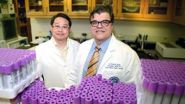(Press-News.org) PHILADELPHIA — The overexpression or underexpression of a newly identified set of genes related to lipid metabolism may help physicians identify whether or not a woman is at risk for hormone receptor-positive or hormone receptor-negative breast cancer and to subsequently tailor prevention strategies appropriately, according to data published in Cancer Prevention Research, a journal of the American Association for Cancer Research.
"Currently, three drugs can be used to prevent breast cancer in women who are at extremely high risk for the disease," said Seema A. Khan, M.D., co-leader of the Breast Cancer Program at the Robert H. Lurie Comprehensive Cancer Center of Northwestern University in Chicago. "However, these drugs prevent only breast cancers that are sensitive to hormones, commonly referred to as estrogen receptor-positive breast cancers; they do not prevent breast cancers that are insensitive to hormones, or estrogen receptor-negative breast cancers.
"We should not expose women at risk for hormone-insensitive breast cancer to the side effects of preventive medications that we know will not work for them," Khan said. "Moreover, if we knew who these women were, we could focus on them in terms of designing new studies to find a solution for preventing hormone-insensitive cancer."
Khan and colleagues sought to find a way to identify women at risk for estrogen receptor-negative breast cancer by examining gene expression in the unaffected breasts of women who had a primary breast cancer of known estrogen-receptor status.
They used this approach because prior research has indicated that if women who have had cancer in one breast subsequently develop a cancer in their second breast, the second cancer is likely to have hormone-receptor status that resembles the first cancer.
Using this logic, Khan and colleagues performed fine-needle aspiration on the unaffected breasts of 15 women with estrogen receptor-positive breast cancer and 15 women with estrogen receptor-negative breast cancer. They validated their results in a second group of women: 12 with estrogen receptor-positive disease, 12 with estrogen receptor-negative disease and 12 healthy controls. The cases in each set were matched by age, race and menopausal status.
The researchers identified 13 genes with significantly higher expression levels in samples from estrogen receptor-negative women. Eight of these genes were associated with lipid metabolism.
"This was interesting because obesity is a breast cancer risk factor for postmenopausal women, but obese women are generally thought to be at increased risk for hormone-sensitive cancer," Khan said. "We were surprised to see that some of these genes that are associated with lipid metabolism, or the metabolism of fats, are actually more highly expressed in the unaffected breasts of women with estrogen receptor-negative breast cancer."
The researchers also found significant overexpression of four of the genes associated with lipid metabolism — DHRS2, HMGCS2, HPGD and ACSL3 — in estrogen receptor-negative samples when compared with healthy women. In estrogen receptor-positive samples, two different lipid metabolism-associated genes — UGT2B11 and APOD — were underexpressed.
"It will be a few more steps before this information is practically useful, but we are hoping that it can take us to a place where we can obtain a breast sample from healthy women, see that they are at risk for a certain type of breast cancer and tailor the prevention strategy accordingly," Khan said.
###
Follow the AACR on Twitter: @aacr
Follow the AACR on Facebook: http://www.facebook.com/aacr.org
About the American Association for Cancer Research
Founded in 1907, the American Association for Cancer Research (AACR) is the world's first and largest professional organization dedicated to advancing cancer research and its mission to prevent and cure cancer. AACR membership includes more than 34,000 laboratory, translational and clinical researchers; population scientists; other health care professionals; and cancer advocates residing in more than 90 countries. The AACR marshals the full spectrum of expertise of the cancer community to accelerate progress in the prevention, biology, diagnosis and treatment of cancer by annually convening more than 20 conferences and educational workshops, the largest of which is the AACR Annual Meeting with more than 17,000 attendees. In addition, the AACR publishes eight peer-reviewed scientific journals and a magazine for cancer survivors, patients and their caregivers. The AACR funds meritorious research directly as well as in cooperation with numerous cancer organizations. As the scientific partner of Stand Up To Cancer, the AACR provides expert peer review, grants administration and scientific oversight of team science and individual grants in cancer research that have the potential for near-term patient benefit. The AACR actively communicates with legislators and policymakers about the value of cancer research and related biomedical science in saving lives from cancer. For more information about the AACR, visit http://www.AACR.org.
END
Charlottesville, VA (March 19, 2013). Researchers at the Hennepin County Medical Center, University of Minnesota, and Minneapolis Medical Research Foundation (Minneapolis, Minnesota) report that the combined use of hyperbaric oxygen and normobaric hyperoxia therapies provides better outcomes in patients with severe traumatic brain injury (TBI) than the standard intensive neurosurgical care recommended for this injury. Full details on the effects of this combined treatment are provided in the paper "A prospective, randomized Phase II clinical trial to evaluate the effect ...
CHICAGO --- A newly identified set of genes may predict which women are at high risk for getting breast cancer that is sensitive to estrogen and, therefore, would be helped by taking drugs to prevent it, reports a new Northwestern Medicine study.
"We now have the possibility of predicting if a preventive drug will work for a woman at high risk of breast cancer, so that we don't expose women to the risks and side effects of this drug if it won't help them," said Seema Khan, M.D., senior author of the study, which will be published March 19, 2013 in the journal Cancer ...
CHICAGO – High-energy lower-extremity trauma (HELET) is common in modern warfare, often resulting in severe tissue damage, chronic pain, neurovascular injury and significant muscle loss, according to the new research presented today at the 2013 Annual Meeting of the American Academy of Orthopaedic Surgeons (AAOS).
The Return to Run (RTR) program is an integrated orthotic and rehabilitation initiative designed to return high-level function to wounded warriors. It includes use of the new Intrepid Dynamic Exoskeletal Orthosis (IDEO), a custom-fit device made from carbon ...
New York, NY (March 18, 2013)—More symptoms of depression and lower cognitive status are independently associated with a more rapid decline in the ability to handle tasks of everyday living, according to a study by Columbia University Medical Center researchers in this month's Journal of Alzheimer's Disease.
Although these findings are observational, they could suggest that providing mental health treatment for people with Alzheimer's disease might slow the loss of independence, said senior author Yaakov Stern, PhD, professor of neuropsychology (in neurology, psychiatry, ...
Teamwork has been fundamental in humanity's greatest achievements but scientists have found that working together has its evolutionary roots in our nearest primate relatives – chimpanzees.
A series of trials by scientists found that chimpanzees not only coordinate actions with each other but also understand the need to help a partner perform their role to achieve a common goal.
Pairs of chimpanzees were given tools to get grapes out of a box. They had to work together with a tool each to get the food out. Scientists found that the chimpanzees would solve the problem ...
The realisation of quantum networks is one of the major challenges of modern physics. Now, new research shows how high-quality photons can be generated from 'solid-state' chips, bringing us closer to the quantum 'internet'.
The number of transistors on a microprocessor continues to double every two years, amazingly holding firm to a prediction by Intel co-founder Gordon Moore almost 50 years ago.
If this is to continue, conceptual and technical advances harnessing the power of quantum mechanics in microchips will need to be investigated within the next decade. Developing ...
Better diagnosis and treatment of cancer could hinge on the ability to better understand a single cell at its molecular level. New research offers a more comprehensive way of analyzing one cell's unique behavior, using an array of colors to show patterns that could indicate why a cell will or won't become cancerous.
A University of Washington team has developed a new method for color-coding cells that allows them to illuminate 100 biomarkers, a ten-time increase from the current research standard, to help analyze individual cells from cultures or tissue biopsies. The ...
Three-quarters of the DNA in evolved organisms is wrapped around proteins, forming the basic unit of DNA packaging called nucleosomes, like a thread around a spool. The problem lies in understanding how DNA can then be read by such proteins. Now, Arman Fathizadeh, a physicist at Sharif University of Technology in Tehran, Iran, and colleagues have created a model showing how proteins move along DNA, in a paper just published in EPJ E.
The problem is that until now, we did not clearly understand the physical mechanisms of how to "open the book" to read the genetic text ...
AUGUSTA, Ga. – A group of tiny RNA molecules with a big role in regulating gene expression also appear to have a role in causing insulin resistance in woman with polycystic ovary syndrome and, perhaps, in all women, researchers report.
Research in the journal Diabetes, indicates that high activity levels of a microRNA called miR-93 in fat cells impedes insulin's use of glucose, contributing to PCOS as well as insulin resistance, said Dr. Ricardo Azziz, reproductive endocrinologist and PCOS expert at the Medical College of Georgia at Georgia Regents University.
"This ...
Researchers at the University of Southampton's Optoelectronics Research Centre (ORC) have created an artificial material, a metamaterial, with optical properties that can be controlled by electric signals.
Photonic metamaterials are artificial materials created by precise and extremely fine structuring of conventional media using nanotechnology. They offer numerous new applications from cloaking to radically improved solar cells. However, the properties of metamaterials are usually fixed.
Dr Eric Plum, Research Lecturer at the ORC, explains: "We have found a fast ...


